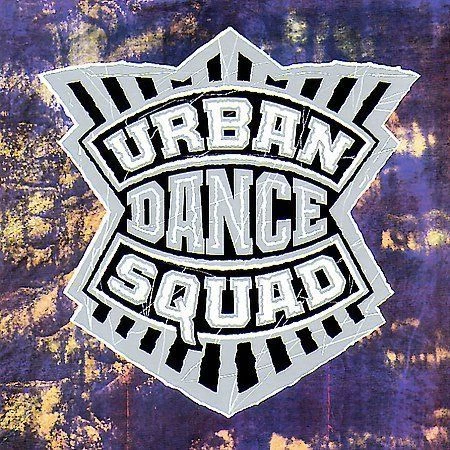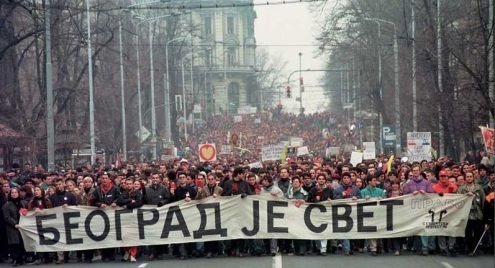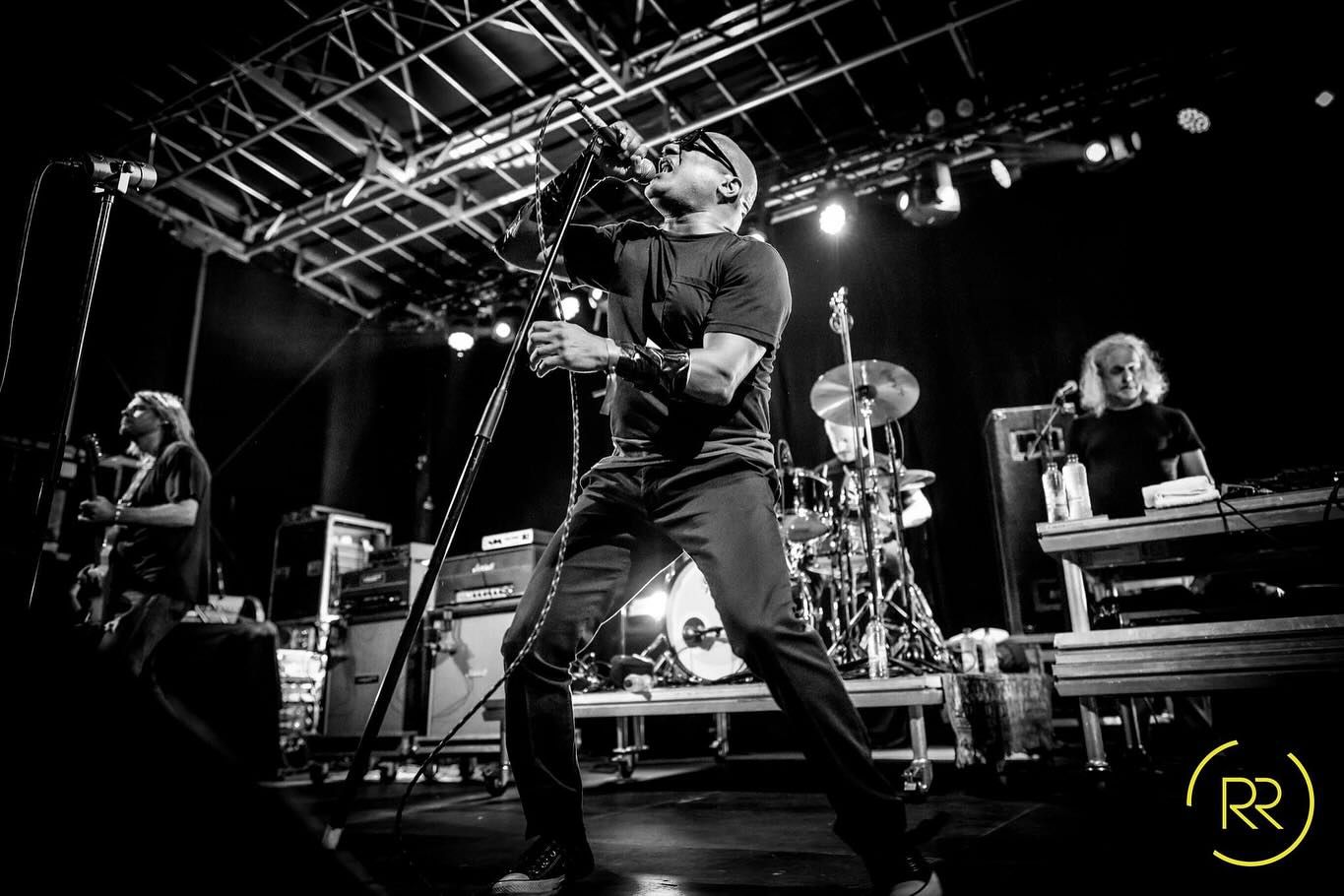One Hit Wondering – Urban Dance Squad

One Hit Wondering is a series of columns where I listen to the album of a one hit wonder, and find three songs, other than the hit, that people should hear.
Genre blending is pretty commonplace for artists and bands today, but back in 1990, when a Dutch fivesome combined hip-hop, rock, and pop, it was downright groundbreaking.
The fivesome was Urban Dance Squad, and the song was “Deeper Shade of Soul.”
Released in 1990, and peaking at #21 on the Billboard Hot 100 in March of ’91, the song, which sampled Ray Barretto's “A Deeper Shade of Soul” from 1968, stayed on the chart for 18 weeks. The blueprint behind its feel good, summery vibe, however, stayed around much longer, and would be used by numerous bands throughout the decade, and beyond.
In fact, it’s pretty easy to draw a direct line from “Deeper Shade of Soul” to Sugar Ray’s 1997 hit “Fly,” and the sound the latter would use for all their future hits.
Urban Dance Squad were actually Sugar Ray before Sugar Ray in more ways than one. It’s not just that they blew up with a radio friendly song, it’s that the song was a complete outlier from the rest of their music. Urban Dance Squad had more rock, and hip-hop elements than “Deeper Shade of Soul” revealed, and Sugar Ray, before “Fly,” was a speed metal band.
The big difference, however, is that while Sugar Ray decided keep the radio friendly vibe, Urban Dance Squad eschewed it in favor of further developing their edge.
That edge is why in addition to being Sugar Ray before Sugar Ray, Urban Dance Squad was also Rage Against The Machine before Rage Against The Machine, and could even be considered one of the grandfathers of nu metal.
Yeah, it’s complicated, but in the end Urban Dance Squad became one of the most successful Dutch bands of the ‘90s, and provided the soundtrack to a massive political movement in foreign country nearly 1,000 miles from their home, all of which is pretty impressive considering they never had any intention of being a band.

The story of Urban Dance Squad began in late December of 1986 at a nightclub in Utrecht named De Vrije Vloer. This is when five artists from totally different genres of music, and totally different walks of life, joined together on stage for the first time to have a jam session.
The fivesome consisted of Rudeboy Remington (vocals), Tres Manos (guitar), Silly Sil (bass), Magic Stick (drums), and DJ DNA (turntables), and they decided to call themselves Urban Dance Squad as an homage to Parliament-Funkadelic’s Urban Dancefloor Guerillas.
As soon as they began performing they became the first Dutch rock band to have a hip-hop artist as a frontman, and their jam session was so talked about by the people who witnessed it that it developed a buzz for the band … even if they weren’t actually a band at that point.
With people wanting to hear the rock outfit fronted by a rapper, Urban Dance Squad were immediately booked for a festival date in their native Netherlands in January of 1987.
Once again, they left a major impression on the crowd, and as time went by, and they officially became a band, they developed a reputation for having high energy shows, which included stage diving, and what can only be described as controlled anarchy.
The anarchy was partially motivated by Rudeboy’s explosive lyrical delivery, which was one part Chuck D, one part Ice-T, and when singing, one part Mike Patton (of Faith No More).
From his intensity, to his lyrical content that focused on social issues much of the time, Rudeboy’s style seems like it might have been an influence on Rage Against The Machine’s Zack de la Rocha. At the very least they were, and could still be, kindred spirits.
So while a sunny, radio-friendly hit was on the way, Urban Dance Squad was actually more symbiotic with bands like Body Count.
The notoriety from their live shows was building, and fans weren’t the only ones who liked what they heard, record labels did, too, and Arista signed the fivesome to a contract that gave the band full creative control.
With that, Urban Dance Squad’s debut album, Mental Floss for the Globe, was released internationally in 1989, and in the U.S. in 1990.
International versions of the album vary in length because a number of uncleared samples had to be removed.
The U.S. version of Mental Floss for the Globe peaked at #54 on the Billboard 200 album chart, but was huge in the band’s native Netherlands, winning an Edison Award, which is the Dutch equivalent of a Grammy.

With their debut album out in the world, and “Deeper Shade of Soul” seeing heavy airplay on radio, and MTV, the band seemed to be set up for success. They even toured the U.S. in 1991, opening for Living Colour.
All, however, was not well within Urban Dance Squad.
Being that the band consisted of five disparate musicians, all of whom appreciated the music they were making, but also had other goals for themselves as artists, it was a constant clash of personalities, and desires.
Their sophomore album, 1991’s Life ’n Perspectives of a Genuine Crossover, featured an even more diverse mix of musical genres than their debut, but group infighting became ever-present.
In the two-part made-for-TV documentary 5 Jaar Wanorde (5 Years of Disorder), which aired in 1992 on Dutch public service broadcaster VPRO’s Onrust!, Magic Stick described the band as “five bullies,” and said that “every show could be our last.”
Just one year later, Magic Stick’s prediction came to fruition for one member of the band, as while they was opening for U2 in France, DJ DNA decided to leave Urban Dance Squad.
What the final straw was for DJ DNA is unknown, but it must have been something pretty major to drop off a tour with U2, who were one of the biggest bands in the world at the time, and were about to release Zooropa.
Urban Dance Squad, however, found a way to play on, releasing Persona Non Grata as a foursome in January 1994, and Planet Ultra, with new band member U-Gene on keyboards, in 1996 (U-Gene would only spend 1996-1997 with the band).
Planet Ultra had a serious tone to it that didn’t find a receptive audience in the Netherlands, but it turned out to be the perfect message at the perfect time in another country, one that was nearly 1,000 miles away, and in the midst of a political upheaval.
The country – Serbia.
It was the winter of 1996, and on November 17th peaceful protests had begun in response to the electoral fraud attempted by President Slobodan Milošević. The fraud stemmed from the 1996 local elections, which had been fixed by Milošević in favor of his party.
The protests on the 17th featured thousands of opposition supporters, and on the 19th students at Belgrade University would join the fold.
Urban Dance Squad had shows booked at the Studentski Kulturni Centar (SKC) in Serbia’s capital, Belgrade, on the 20th, and 21st.
Being that bands from Western Europe rarely performed in Serbia, the shows had garnered a lot of attention well in advance, and the venue was going to be packed each night.
Performing to a crowd of over 2,000 people on night one, the band’s music turned out to be the perfect soundtrack for the country’s social unrest, and the set from that night would be released as a live album titled Beograd Live.
The show on the 21st would prove to be even wilder, as it wound up coinciding with the protests of Milošević making their way to Belgrade, all the way to right outside the venue.

A peaceful demonstration going on outside, a riotous show going on inside, both perfect representations of the feelings of the people of Belgrade.
On February 4th of the following year, after 96 days of protests, and two blistering Urban Dance Squad shows, Milošević finally recognized the opposition victories in some local elections.
Back in Urban Dance Squad’s local area, the band reunited with DJ DNA, and in 1999 they released their fifth studio album, titled Artantica (that’s not a typo). The reunion was short-lived, however, as the five members of Urban Dance Squad decided to go their separate ways the following year.
Hitting the fast-forward button, it’s said that time heals all wounds, and while all seems like a lofty sum, as the years passed at least a few of the wounds from the Urban Dance Squad days were healed for two of its members, with a reuniting of Rudeboy and DJ DNA occurring in 2022. The two are now joined by new band members Axel van Oort (bass), Jochem van Rooijen (drums), and Matthias van Beek (guitar), and are touring as Rudeboy Plays Urban Dance Squad Feat. DJ DNA.

In addition to the reformed, and revamped band, Rudeboy – who had previously recorded vocals for Junkie XL’s first two albums, and performed under a litany of different monikers – has been recording as a solo artist, and released an autobiography titled Inside Outsider earlier this year.
Bringing things back to Urban Dance Squad’s debut album, Mental Floss for the Globe, the LP is still considered a massive achievement in the band’s native Netherlands. As recently as 2008 it was named the best Dutch pop album of all-time by Dutch music magazine OOR.
The honor may have stung a bit for Rudeboy, who was always frustrated that he could never earn the respect he desired in the hip-hop world after having had a pop hit.
“Deeper Shade of Soul,” however, was more than just a pop hit, it was a song that helped kick off an era of genre blending, and musical experimentation that defined the ‘90s.
With that in mind, I gave Mental Floss for the Globe a spin, and found three songs, other than “Deeper Shade of Soul,” that you should hear.
“Man on the Corner”
“Man on the Corner” would have been an ideal follow up to “Deeper Shade of Soul.” Rudeboy’s vocal style is similar on both songs, which is good for listener recognition, while lyrically “Man on the Corner” has more social commentary, and musically there’s more funk to it. It really would’ve been a perfect bridge from their pop hit, to who they actually were as a band.
“Brainstorm on the U.D.S.”
A song that sounds like a seedling that eventually gave birth to nu metal, “Brainstorm on the U.D.S.” has a number of elements that created the subgenre – record scratching, a guitar riff, raw energy. I can only imagine how insane this one was live.
“Famous When You’re Dead”
There’s no way you can listen to this song and not think it sounds like a blueprint for Rage Against The Machine.
Of course, Rage came along just one year after Mental Floss for the Globe was released in the U.S., so there’s also a really good chance this was simply a case of great musical minds thinking alike, but the similarities are wild.
Until next time, here’s to discovering more great music from one hit wonders!

Comments